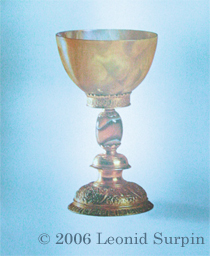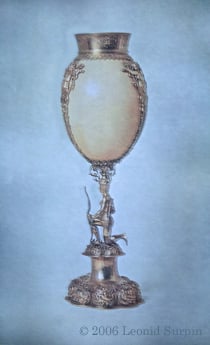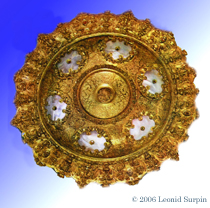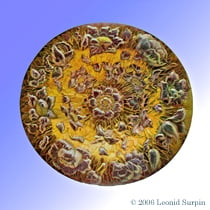Influence of Poisons on Silverware Design.
March 6, 2010
Preamble
We often use things surrounding us without much thinking of their origin, and why they are this, or that particular way. I have always been interested in old techniques and very frequently the best way to decipher a manufacturing method is to understand the reasons behind it. Silverware design in general and shape of drinking vessels in particular, is an area of exploration of this writing.
Introduction
To understand silverware design, we have to deal with dark pages of Human History. This is simply unavoidable. We all like to believe in goodness of our fellow human being, but History lessons cannot be ignored. We need to understand the role of poisons and their effects on civilization.
Poisons in Ancient World.
Here is a link to article, which is a very good introduction to the subject
Poisons In Ancient Rome
For those who do not have time to read complete text, here is an excerpt from the article.
Poisons and poisoning are frequently mentioned in Roman literature. The question whether the murder-rate and the percentage of suicides were greater than they are today is still debatable and cannot be decided with any degree of accuracy. Scholars cannot even agree on the size of the population of Rome itself at any given period, in spite of much research and many deductions. Much less can the death-rates from unnatural causes be determined. However, the crime of poisoning seems to have been much more frequent in ancient than in modern times. Perhaps this can be attributed to the absence of gunpowder and bullets.
The word venenum is derived, according to Walde,1 from Venus and means a love potion. It has three meanings from actual usage: remedy, 2 poison, 3 and magic drug or abortive. 4 The exact meaning is frequently determined by the qualifying adjective bonum or malum. 5 Veneficium means poisoning6 and practicing sorcery, 7 while veneficus or venefica was applied to a poisoner8 or maker of drugs. 9 However, in this paper we are primarily concerned with poisoning.
The first known instance of the crime of poisoning at Rome was in 331 B.C., when a high mortality, the result, probably, of a pestilence, was attributed to poisoning. Even Livy doubted the validity of the charges, but he10 gives the whole account as found in his sources. After many leading citizens had died from the same disease, a slave-girl gave information to the curule aediles that the reason for this high mortality was the poisons prepared and administered by the Roman matrons.
On investigation they found about twenty matrons, including patrician ladies, in the act of brewing poisons, which they declared were salutary. On being forced to drink their own concoctions to prove the charges false, they perished by their own wickedness. Following this, a hundred and seventy more were found guilty of the same offense. The second case of extensive poisoning is found in 186 B.C. in connection with the licentious worship of Bacchus. After a careful and extensive investigation of four months, carried on throughout Italy, the praetor Quintus Naevius made a grand exposé resulting in the condemnation of two thousand persons. Poisoning was one of the crimes prominently mentioned with the rest.
I want to bring your attention to the underlined sentence in bold. Bacchus was a god of Wine and Bacchus worship was basically a drinking orgy, accompanied with, let’s use the proper term, lascivious activities. This is one of the earliest, if not the first, documented case of mass poisoning with wine. Since, it is unlikely that many people would be targeted for assassination in this manner, we have a documented case mass poisoning with bad wine. This is an important point for later discussion.
Poisons in Middle Ages and Onward
Let’s start with link as recommended reading.
brief history of poisoning
This website has tremendous wealth of information on subject of poisons. Also pay attention to the links. A very worthwhile reading. Here is an except for time conscious readers:
In the 8th Century AD, poisoning took another step forward when an Arab chemist successfully transformed arsenic into an odourless, tasteless powder that would elude detection for at least ten centuries, thus providing the sinister world of poisoners with the convenient and deadly ‘inheritance powder’.
By the Middle Ages, poisons were common trade in apothecaries, and available to the general public. While knowledge in other fields degenerated in the West as a result of religion, knowledge of poisons continued to bloom. Many academic texts were written on the subject by monks, among them The Book of Venoms (1424) by Magister Santes de Ardoynis, which told of known poisons at the time, how they worked, and how they could be treated.
Though most of these texts were unavailable to the public, the populace had their own (dubious) knowledge of poisons as well as equally (dubious) bizarre methods of dealing with poisoning, which included drinking from vessels with alleged magical properties and using charms and religious talismans to ward off poisoning. Most of these were obtained from the Jews7.
As the Renaissance surged through Europe, so did the popularity of poison as a method of disposing of people who were in the way. You could almost say that poisoning had become fashionable — certainly it was the most convenient way of migrating into the upper circle of society. The most infamous example from this era is that of the Borgia family, who migrated from Spain to Italy around 1455 and whose name became synonymous with dinner-party executions. The most well-known member of this family was the notorious femme fatale Lucrezia Borgia8, who formed a ghastly poisoners’ triumvirate with her father Pope Alexander VI9 and brother Cesare, and whose reputation as a poisoner has achieved a sort of mythic immortality.
The study of poisons during the 14th and 15th Centuries, coupled with the experimentation by Italian alchemists to create more potent poisons from classical bases, spread from Italy to Paris, thanks to the efforts of Queen Catherine De Medici10, and paved the way for a boom in the poisoners’ industry as the poisoning epidemic (and, subsequently, paranoia, especially in the upper class) surged through Europe. By 1572, at least 30,000 self-named poisoner ‘sorcerers’ were running rampant in the streets of Paris. A poisoner-assassins’ guild called the Council of Ten was established in Italy during the 16th Century by a group of alchemists, to provide ‘elimination’ services for a fee. A publication called Neopoliani Magioe Naturalis (1589) by Giovanni Battista Porta served as a textbook for poisoners, especially with regard to lacing wine with a deadly concoction called Veninum Lupinum, composed of aconite, taxus baccata, caustic lime, arsenic, bitter almonds, powdered glass and honey, and shaped into walnut-sized pills. An arsenic-infused solution called Acqua Toffana, invented by a Neapolitan woman by the name of Toffana, was marketed as a ladies’ cosmetic under the guise of a ‘miraculous substance oozing from the tomb of St Nicholas di Bari’, but was famous among widows for more sinister purposes11. By the 17th Century, schools of poisoning had been established in both Venice and Rome, and women who had been elbow-deep in poisoning schemes from the start, now took their murderous crimes to a higher level by forming secret societies in which they received not only instructions on the administration of poison, but the weapons themselves. Poisoning had transcended murder to become art.
I have underlined a portion of the text to point out that wine was a vehicle of choice to expose a target of assassination to poison. That was done because wine could go bad on it’s own, and it was difficult to prove whether poison got into the wine intentionally, or simply was a by-product of winemaking process.
One of the interesting questions to consider is how much of fear was due to actual attempts on life, and how much was because of improperly prepared food and wine. After all, a lot of things can go wrong in a kitchen or a wine cellar.
To my utter surprise, I discovered that a mere suggestion that wine can become contaminated as a result of wine making process, are a fighting words in some circles.
I do not want to indict their motives, but resistance to that idea are mostly from individual associated with wine industry. I suspect that they feel that somehow it could affect their business. I want to put their minds at rest. I am not on a crusade to put them out of business by making people unease about drinking wine.
Let’s consider what could had gone wrong with winemaking process, to turn wine into deadly poison.
There are number of fruits and vegetable that contain cyanide compounds which can be converted to deadly form of cyanide upon ingestion. Here is text, compliments of Canadian Food Inspection Agency
http://www.inspection.gc.ca/english/fssa/concen/specif/fruvegtoxe.shtml
nothing special about this particular text, here is another one
http://www.ch.ic.ac.uk/rzepa/mim/environmental/html/hcn_text.htm
The point been is that a winemaker, facing a bad crop but needed wine to survive, because it was the only thing that he grows, could be motivated to use other fruits for winemaking, and some of these add-ons could had contained cyanogenic compounds.
My friends from wine lobby arguing that grapes do not contain cyanide and/or cyanogenic compounds, which is true, but is that a complete truth? Let me introduce a new actor, whose name is Snow Mold. If you are not a gardener, you probably would not know who it is, so here is the explanation
http://www.extension.umn.edu/yardandgarden/ygbriefs/p320snowmolds.html
Once you familiarize yourself with our little friend, it is time to read following text
http://mic.sgmjournals.org/cgi/reprint/116/1/9.pdf
I know it is heavy going, but stiffen your spine and persevere. Pay special attention to references at the end. There are appears to be a tons of literature on the subject. Do you think that professors of viticulture, who are so often quoted, should know about it. Snow mold is a very common fungus. Do my wine lobby friends really want to argue that there was no possibility of fermentation vats getting some of it. Now fermentation is carried out in stainless steel tanks, which are disinfected before every use, but it was not the case 500 years ago. And where do you think this practice of cleaning fermentation tanks came from?
Evolution of Silverware design to safeguard against poisoning
As a goldsmith, I am interested the most in how all that was influencing design and techniques of silverware and jewellery. The raisons d’être of goldsmithing is to meet the demand for things, which make everyday life more fun, so it is very illuminating to examine how our brethren rose to the occasion.
Let’s take look at some examples:

The earliest drinking vessels were horns. It was believed that horn on contact with poison would vibrate and thereby inform of the danger. Cellar master wore pieces of horns attached to silver chain. Before tasting wine, the horn was lowered into the liquid and observed for reaction. Silversmiths capitalized on that belief and produced number of articles for people who could afford them. The picture above shows an example of such vessels. It was made by Jacob Mores, who worked in the period from 1579 to 1609.

Rock Crystal was also used as poison indicator. It was believed that upon contact with poison, the crystal looses it’s transparency. This is happens to be a very rare piece. It was made by Albrecht Jamnitzer, who achieved status of the master only 5 years before his death. Only a few pieces of his work are known. All are dated to 1550 – 1555.

Another material used for protection, was agate. Agate was highly prized gemstone in XVI century, mostly due to believe in it’s magical properties. Agate would not show if poison was present in wine, agate would render poison harmless, as the legends tell us.The cup was made by master Elias Lencker, who worked in 1562 – 1591

Use of the ostrich egg shell is very interesting. A very wide-spread superstition in Middle Ages was that any egg shell, after egg was eaten, must be broken. If not, than a witch could make egg shell grow as large as a boat and use it to get around to do evil deeds. Ginrich Ohmsen, who made this goblet between 1636 and 1640, solved the problem by encasing the egg shell into silver cage. Now it was impossible for any witch to turn it into a boat, and he would not be responsible for enabling witchcraft. The egg shell would give the same reaction to poison as mother of pearl.
 One would be remiss not mentioning use of Nautilus shells. Nautilus shell was also known as “Ship of Pearls” due to high quality mother of pearl, lining it’s inside. One motivation for using this material, could had been to associate with legend of Cleopatra, who was drinking pearls dissolved in wine to enhance her appearance. If poison was present, mother of pearl would loose it’s sheen and transparency. Master unknown, dated pre 1644
One would be remiss not mentioning use of Nautilus shells. Nautilus shell was also known as “Ship of Pearls” due to high quality mother of pearl, lining it’s inside. One motivation for using this material, could had been to associate with legend of Cleopatra, who was drinking pearls dissolved in wine to enhance her appearance. If poison was present, mother of pearl would loose it’s sheen and transparency. Master unknown, dated pre 1644
 This is what is known as double goblet. A smaller goblet is used as cover as well as goblet. What is interesting about it is that repousse was used not only as decorative technique, but also as structural. The teardrop volumes stiffened the whole structure, and at the same time showed off superior reflective ability of silver. It should not be overlooked that on the inside, the edges of these areas would be first to react to presence of poison, so even minute discoloration would be noticeable due to it’s shape.Unknown master, dated pre 1520.
This is what is known as double goblet. A smaller goblet is used as cover as well as goblet. What is interesting about it is that repousse was used not only as decorative technique, but also as structural. The teardrop volumes stiffened the whole structure, and at the same time showed off superior reflective ability of silver. It should not be overlooked that on the inside, the edges of these areas would be first to react to presence of poison, so even minute discoloration would be noticeable due to it’s shape.Unknown master, dated pre 1520.
Another interesting type of silverware are salvers. The name itself is very revealing of the purpose. Etymology of salver from French salve, from Spanish salva (tasting of food to detect presence of poison), from salva (save), from Latin salvare (to save). Another term for this former practice of sampling food is credence.
Let’s look at some examples
 Master Hans Brabant, worked 1535 – 1569. Mother of pearl medallions function as poison indicators.
Master Hans Brabant, worked 1535 – 1569. Mother of pearl medallions function as poison indicators.
 Center composition in silver, functions as poison indicator, but it does more than that. Composition depict the finale of legend “Apollo and Daphne” when Daphne just about to be caught, turns herself into laurel tree. Since cherry laurel was primary source of cyanide in Middle Ages, it is possible that a warning was intended. Master Ditrich Moye, worked 1633 – 1653.
Center composition in silver, functions as poison indicator, but it does more than that. Composition depict the finale of legend “Apollo and Daphne” when Daphne just about to be caught, turns herself into laurel tree. Since cherry laurel was primary source of cyanide in Middle Ages, it is possible that a warning was intended. Master Ditrich Moye, worked 1633 – 1653.
 Master Hans III Lambrecht, worked 1630 – 1683. I have included this salver not because of some unusual technique, but because of it’s composition. Floral elements on gilded background. The artistic sense of the goldsmith is impeccable. This salver could have been made yesterday. There is absolutely nothing to pin it to a particular time period. A truly timeless masterpiece.
Master Hans III Lambrecht, worked 1630 – 1683. I have included this salver not because of some unusual technique, but because of it’s composition. Floral elements on gilded background. The artistic sense of the goldsmith is impeccable. This salver could have been made yesterday. There is absolutely nothing to pin it to a particular time period. A truly timeless masterpiece.
Conclusion
The word poison conjures up images of evil and suffering, but as we know now, it was discovered in pursuit of love. In search for the antidote, a lot of beautiful things were created and medical knowledge was advanced. If not for poison, the profession of goldsmith probably would not exist. Should we be surprised by creative force of poison in general and cyanide in particular ?
As a parting gift, I will present you with this link
http://dsc.discovery.com/news/2008/01/17/galaxy-amino-acid.html
Judge for yourself.
Leonid Surpin.
www.studioarete.com









